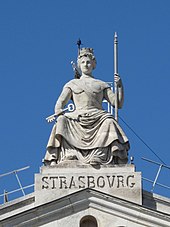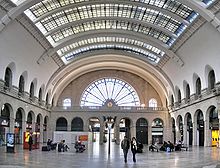Paris-Est train station
| Paris-Est Gare de l'Est |
|
|---|---|
|
Panorama Gare de l'Est , 2007
|
|
| Data | |
| Location in the network | Terminus |
| Design | Terminus |
| Platform tracks | 29 |
| IBNR | 8700011 |
| opening | July 5, 1849 |
| Architectural data | |
| architect | François-Alexandre Duquesney |
| location | |
| City / municipality | Paris |
| Department | Paris |
| region | Île-de-France |
| Country | France |
| Coordinates | 48 ° 52 '37 " N , 2 ° 21' 33" E |
| Railway lines | |
|
|
| List of train stations in France | |
The Paris-Est train station - Gare de l'Est ( German Ostbahnhof ) - is one of the six major Parisian terminal stations . It is located in the 10th arrondissement , not far from the Gare du Nord ( German North Station ). With 34 million passengers a year (93,000 per day) it is the fifth largest train station in Paris.
history
The Gare de l'Est was founded in 1849 by the Compagnie du chemin de fer de Paris à Strasbourg under the name Embarcardère de Strasbourg (a term borrowed from the still young railway from the seafaring, which actually means embarkation, boat landing stage , so analogously the departure point for Strasbourg ) opened. After the first of a series of enlargements, which became necessary due to the opening of a new line to Mulhouse in Upper Alsace by the operating company renamed Compagnie de l'Est (EST), the station was given its current name in 1854.
On October 4, 1883, the Gare de l'Est was the scene of the departure of the first Orient Express to Constantinople .
In the years 1885 and 1900 the Gare de l'Est underwent major renovations. In the state of 1900 the station had 16 platform tracks. Outside the platform systems there were two arrival, departure and traffic tracks. The reception building was divided into a wing for incoming and one for outgoing traffic. The baggage handling was in an eastern extension.
During the First World War , many soldiers began their journey to the front at the Gare de l'Est. Remember since 1926 by the American painter Albert Herter created monumental painting Le Départ of poilus, août 1914 (dt. The departure of the soldiers at the front, August 1914 ; French. Poilus the nickname was for French combat soldiers in World War I) in the departure hall and since 1929 the name of the nearby avenue de Verdun, as well as the name of the metro station Gare de l'Est - Verdun .
The rapid increase in suburban traffic after the First World War led to a renewed renovation of the station in 1930. As a result of settlement activities in the Parisian banlieue , the EST had to insert further suburban trains. The station recorded 25 train journeys every hour between 5 p.m. and 8 p.m., with 24,000 people traveling in suburban traffic during this time. Long-distance traffic also recorded strong growth, rising from twelve million travelers in 1910 to around 26 million travelers in 1926. The number of trains had almost doubled from 295 to 472 between 1903 and 1927. The EST headquarters therefore decided to extensively expand the railway facilities. The number of platform tracks was to be increased from 16 to 31, while the existing platforms were to be extended from 275 meters to 300 meters in length. By adding three additional tracks, three trains should be able to arrive or depart from three additional traffic tracks. Baggage handling was to be enlarged and a new facade around 200 meters long had to be built. Last but not least, the transfer situation to the metro station of the same name should also be improved. The new track plan provided tracks 1–10 for departing long-distance trains, track 11–23 was intended for arriving and departing suburban trains and track 24–31 for arriving long-distance trains.
In the run-up to the work, the local freight station had to be shut down and rebuilt outside the city limits. The company also had to buy several plots of land for the relocation of Rue de Faubourg-Saint-Martin and build two residential buildings for the residents to be relocated. In order to gain more space for the platforms, the new station building was built on several floors and no side extensions were made. The building is divided into three parts with two reception halls and the associated facilities such as ticket offices for long-distance and local transport. Both halls are connected by a central corridor, which is followed by a spacious luggage hall in the central building. To the north of the halls, there was an approximately 25-meter-wide transverse platform , which, like the outgoing central platforms, is at street level. In addition to the main entrance on Rue de Strasbourg , two side entrances were created on Rue d'Alsace and Rue de Faubourg Saint-Martin . Between the cross platform and the baggage hall, two staircases led to the distribution level of the metro station and another main hall. A pedestrian tunnel connected the hall with the south side of the Rue de Strasbourg and a traffic island in between . The second basement was prepared for luggage traffic. All platforms could be reached from the baggage hall via a longitudinal and a cross aisle. Two passenger elevators and three flights of stairs connected the cross platform with the baggage claim area. The upper floors were used for service rooms. The creation of the baggage tunnels made it possible to dispense with separate baggage platforms between the tracks. The renovation project was completed in 1931 and the cost was around 300 million francs .
traffic
The Gare de l'Est is served by both international and intra-French long-distance trains. The station is also approached by local trains. Inside the station there is also access to the Gare de l'Est station of the Paris Métro of the same name .
International long-distance transport
Destinations in Luxembourg and Germany are served in high-speed trains with TGV and ICE . These trains use the LGV Est européenne high-speed line , which went into operation in June 2007 . Destination stations in Germany are Karlsruhe , Stuttgart , Ulm , Augsburg and Munich as well as Saarbrücken , Kaiserslautern , Mannheim and Frankfurt am Main . Since December 9, 2018, a daily connection to Freiburg has been offered via Offenburg . Alleo , a joint venture between French and German railways, is responsible for the connections with Germany .
The Gare de l'Est is the starting point of the night train EN 452/453 to Moscow , which is operated by the Russian state railway RŽD .
The luxury train Venice-Simplon-Orient-Express stops at the station several times a year .
National long-distance transport
Many destinations in the eastern departments of France ( Grand Est region ) can be reached with the TGV . The most important are the Strasbourg , Metz , Nancy and Reims train stations .
Broad genus Intercités circulate among others to Dijon and Belfort .
Local transport
The station is the western terminus of the TER Champagne-Ardenne regional train network .
Subway
Lines 4 , 5 and 7 , which are operated by RATP , stop at Gare de l'Est of the Métro .
Former connections
From 2007 to 2011, trains ran to Switzerland from the Gare de l'Est . When the LGV Rhin-Rhône high-speed line went into operation in December 2011, these trains changed their route and have been running from Gare de Lyon since then .
The night trains of Deutsche Bahn to Berlin and Munich , which were discontinued at the end of 2014, also departed from Gare de l'Est as the City Night Line .
literature
- Wolfgang Klee, Stefan Vockrodt: To the east: Gare de l'Est and Bastille . In: Railway history special 2. Railways in Paris . 2015, ISBN 978-3-937189-94-9 , pp. 22-29 .
Web links
Information from the SNCF about the Gare de l'Est
Individual evidence
- ↑ a b c Spamer: The expansion of the Paris Ostbahnhof . In: Zentralblatt der Bauverwaltung . No. 33 . Berlin August 20, 1930, p. 582-586 ( zlb.de [accessed April 1, 2017]).





